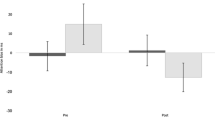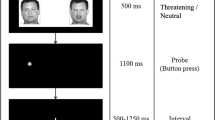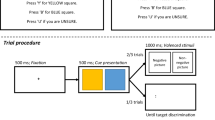Abstract
Background
People with anxiety difficulties show different patterns in their deployment of attention to threat compared to people without anxiety difficulties. These attentional biases are assumed to play a critical role in the development and persistence of anxiety. However, little is known about factors that influence attentional biases to threat. An emerging body of evidence suggests that visual attention to threat varies across the time course according to one’s motivation to approach vs. avoid threat.
Methods
In order to better understand the relationship between motivation, attentional biases to threat, and anxiety, we had participants high in spider fear complete a sustained-attention task in full view of a live tarantula while their eye movements were tracked.
Results
Participants who were ambivalent about whether to look at the spider or to avoid looking exhibited a unique pattern of visual attention to the spider, and reported higher spider fear and more negative affect than did other participants at the end of the study.
Conclusions
Our findings suggest that anxiety persistence may have more to do with goal prioritization than innate attentional biases. Future studies of attentional biases to threat should take motivation into account and study attention across the time course. Ambivalent motivation to threat should also be targeted in exposure therapy.

Similar content being viewed by others
References
Amir, I., Zvielli, A., & Bernstein, A. (2016). (De) coupling of our eyes and our mind’s eye: A dynamic process perspective on attentional bias. Emotion, 16(7), 978–986. https://doi.org/10.1037/emo0000172.
Amir, N., Elias, J., Klumpp, H., & Przeworski, A. (2003). Attentional bias to threat in social phobia: Facilitated processing of threat or difficulty disengaging attention from threat? Behaviour Research and Therapy, 41(11), 1325–1335. https://doi.org/10.1016/s0005-7967(03)00039-1.
Andersson, G., Waara, J., Jonsson, U., Malmaeus, F., Carlbring, P., & Ost, L. G. (2009). Internet-based self-help versus one-session exposure in the treatment of spider phobia: a randomized controlled trial. Cognitive Behaviour Therapy, 38(2), 114–120. https://doi.org/10.1080/16506070902931326.
Bar-Haim, Y., Lamy, D., Pergamin, L., Bakermans-Kranenburg, M. J., & van IJzendoorn, M. H. (2007). Threat-related attentional bias in anxious and nonanxious individuals: a meta-analytic study. Psychological Bulletin, 133(1), 1–24. https://doi.org/10.1037/0033-2909.133.1.1.
Bryant, R. A., & Harvey, A. G. (1995). Processing threatening information in posttraumatic stress disorder. Journal of Abnormal Psychology, 104(3), 537–541.
Buckley, T. C., Blanchard, E. B., & Hickling, E. J. (2002). Automatic and strategic processing of threat stimuli: A comparison between PTSD, panic disorder, and non-anxiety controls. Cognitive Therapy and Research, 26(1), 97–115.
Chen, M., & Bargh, J. A. (1999). Consequences of automatic evaluation: Immediate behavioral predispositions to approach or avoid the stimulus. Personality and Social Psychology Bulletin, 25(2), 215–224.
Cisler, J. M., & Koster, E. H. (2010). Mechanisms of attentional biases towards threat in anxiety disorders: An integrative review. Clinical Psychology Review, 30(2), 203–216. https://doi.org/10.1016/j.cpr.2009.11.003.
Cisler, J. M., & Olatunji, B. O. (2010). Components of attentional biases in contamination fear: evidence for difficulty in disengagement. Behaviour Research and Therapy, 48(1), 74–78. https://doi.org/10.1016/j.brat.2009.09.003.
Crawford, J. R., & Henry, J. D. (2004). The positive and negative affect schedule (PANAS): Construct validity, measurement properties and normative data in a large non-clinical sample. British Journal of Clinical Psychology, 43(Pt 3), 245–265.
Derryberry, D., & Reed, M. A. (2002). Anxiety-related attentional biases and their regulation by attentional control. Journal of Abnormal Psychologuy, 111(2), 225–236.
Dunning, J. P., & Hajcak, G. (2009). See no evil: directing visual attention within unpleasant images modulates the electrocortical response. Psychophysiology, 46(1), 28–33. https://doi.org/10.1111/j.1469-8986.2008.00723.x.
Elliot, A. J., & Thrash, T. M. (2002). Approach-avoidance motivation in personality: approach and avoidance temperaments and goals. Journal of Personality and Social Psychology, 82(5), 804–818. https://doi.org/10.1037/0022-3514.82.5.804.
Faul, F., Erdfelder, E., Lang, A.-G., & Buchner, A. (2007). G*Power 3: A flexible statistical power analysis program for the social, behavioral, and biomedical sciences. Behavior Research Methods, 39(2), 175–191.
Fowles, D. C. (1987). Psychophysiology and psychopathology: A motivational approach. Psychophysiology, 25(4), 373–391.
Fox, E., Russo, R., Bowles, R., & Dutton, K. (2001). Do threatening stimuli draw or hold visual attention in subclinical anxiety? Journal of Experimental Psychology: General, 130(4), 681–700. https://doi.org/10.1037/0096-3445.130.4.681.
Gray, J. A., & McNaughton, N. (2000). The neuropsychology of anxiety: An enquiry into the functions of the septo-hippocampal system (2nd ed.). Oxford: Oxford University Press.
Healey, A., Mansell, W., & Tai, S. (2019). How does goal conflict, and awareness of goal conflict, relate to distress, dysfunction and the outcomes of exposure in spider fear? https://doi.org/10.13140/RG.2.2.22398.43843.
Hermans, D., Vansteenwegen, D., & Eelen, P. (1999). Eye movement registration as a continuous index of attention deployment: Data from a group of a spider anxious students. Cognition and Emotion, 13(4), 419–434.
Johnson, D. R. (2009). Goal-directed attentional deployment to emotional faces and individual differences in emotional regulation. Journal of Research in Personality, 43(1), 8–13. https://doi.org/10.1016/j.jrp.2008.09.006.
Kamphuis, J. H., & Telch, M. J. (2000). Effects of distraction and guided threat reappraisal on fear reduction during exposure-based treatments for specific fears. Behaviour Research and Therapy, 38(12), 1163–1181. https://doi.org/10.1016/s0005-7967(99)00147-3.
Kashdan, T. B., Adams, L., Read, J., & Hawk, L., Jr. (2012). Can a one-hour session of exposure treatment modulate startle response and reduce spider fears? Psychiatry Research, 196(1), 79–82. https://doi.org/10.1016/j.psychres.2011.12.002.
Kelly, R. E., Mansell, W., & Wood, A. M. (2015). Goal conflict and well-being: A review and hierarchical model of goal conflict, ambivalence, self-discrepancy and self-concordance. Personality and Individual Differences, 85, 212–229. https://doi.org/10.1016/j.paid.2015.05.011.
Klein, A. M., Becker, E. S., & Rinck, M. (2011). Approach and avoidance tendencies in spider fearful children: the approach-avoidance task. Journal of Child and Family Studies, 20(2), 224–231. https://doi.org/10.1007/s10826-010-9402-7.
Koster, E. H., Crombez, G., Verschuere, B., Van Damme, S., & Wiersema, J. R. (2006). Components of attentional bias to threat in high trait anxiety: Facilitated engagement, impaired disengagement, and attentional avoidance. Behaviour Research and Therapy, 44(12), 1757–1771. https://doi.org/10.1016/j.brat.2005.12.011.
Lipp, O. V., Derakshan, N., Waters, A. M., & Logies, S. (2004). Snakes and cats in the flower bed: Fast detection is not specific to pictures of fear-relevant animals. Emotion, 4(3), 233–250. https://doi.org/10.1037/1528-3542.4.3.233.
Mathews, A., & Mackintosh, B. (1998). Cognitive model of selective processing in anxiety. Cognitive Therapy and Research, 22(6), 539–560. https://doi.org/10.1023/A:1018738019346.
Mogg, K., & Bradley, B. P. (1998). A cognitive-motivational analysis of anxiety. Behaviour Research and Therapy, 36(9), 809–848.
Mogg, K., & Bradley, B. P. (2005). Attentional bias in generalized anxiety disorder versus depressive disorder. Cognitive Therapy and Research, 29(1), 29–45. https://doi.org/10.1007/s10608-005-1646-y.
Mogg, K., & Bradley, B. P. (2006). Time course of attentional bias for fear-relevant pictures in spider-fearful individuals. Behaviour Research and Therapy, 44(9), 1241–1250. https://doi.org/10.1016/j.brat.2006.05.003.
Mogg, K., Bradley, B. P., Miles, F., & Dixon, R. (2004). Time course of attentional bias for threat scenes: Testing the vigilance-avoidance hypothesis. Cognition & Emotion, 18(5), 689–700. https://doi.org/10.1080/02699930341000158.
Muris, P., & Merckelbach, H. (1996). A comparison of two spider fear questionnaires. Journal of Behavior Therapy and Experimental Psychiatry, 27(3), 241–244.
Nelson, A. L., Purdon, C., Quigley, L., Carriere, J., & Smilek, D. (2015). Distinguishing the roles of trait and state anxiety on the nature of anxiety-related attentional biases to threat using a free viewing eye movement paradigm. Cognition Emotion, 29(3), 504–526. https://doi.org/10.1080/02699931.2014.922460.
Ohman, A., Flykt, A., & Esteves, F. (2001). Emotion drives attention: Detecting the snake in the grass. Journal of Experimental Psychology. General, 130(3), 466–478. https://doi.org/10.1037/AXJ96-3445.130.3.466.
Paulitzki, J. R., Risko, E. F., Oakman, J. M., & Stolz, J. A. (2008). Doing the unpleasant: How the emotional nature of a threat-relevant task affects task-switching. Personality and Individual Differences, 45(5), 350–355. https://doi.org/10.1016/j.paid.2008.05.003.
Pittig, A., Brand, M., Pawlikowski, M., & Alpers, G. W. (2014). The cost of fear: Avoidant decision making in a spider gambling task. Journal of Anxiety Disorders, 28(3), 326–334. https://doi.org/10.1016/j.janxdis.2014.03.001.
Psychology Software Tools, I. (2007). E-prime 2.0 professional. Pittsburgh: Psychology Software Tools, Inc.
Rachman, S. (2004). Anxiety (2nd ed.). Hove: Psychology Press.
Ranganathan, P., Pramesh, C. S., & Buyse, M. (2016). Common pitfalls in statistical analysis: The perils of multiple testing. Perspectives in Clinical Research, 7(2), 106–107. https://doi.org/10.4103/2229-3485.179436.
Richeson, J. A., & Trawalter, S. (2008). The threat of appearing prejudiced and race-based attentional biases. Psychological Science, 19(2), 98–102. https://doi.org/10.1111/j.1467-9280.2008.02052.x.
Rinck, M., & Becker, E. S. (2006). Spider fearful individuals attend to threat, then quickly avoid it: Evidence from eye movements. Journal of Abnormal Psychology, 115(2), 231–238. https://doi.org/10.1037/0021-843X.115.2.231.
Rinck, M., & Becker, E. S. (2007). Approach and avoidance in fear of spiders. Journal of Behavior Therapy and Experimental Psychiatry, 38(2), 105–120. https://doi.org/10.1016/j.jbtep.2006.10.001.
Rinck, M., Becker, E. S., Kellermann, J., & Roth, W. T. (2003). Selective attention in anxiety: Distraction and enhancement in visual search. Depression and Anxiety, 18(1), 18–28. https://doi.org/10.1002/da.10105.
Rinck, M., Reinecke, A., Ellwart, T., Heuer, K., & Becker, E. S. (2005). Speeded detection and increased distraction in fear of spiders: Evidence from eye movements. Journal of Abnormal Psychology, 114(2), 235–248. https://doi.org/10.1037/0021-843X.114.2.235.
Seli, P., Carriere, J. S., & Smilek, D. (2015a). Not all mind wandering is created equal: Dissociating deliberate from spontaneous mind wandering. Psychological Research, 79(5), 750–758. https://doi.org/10.1007/s00426-014-0617-x.
Seli, P., Cheyne, J. A., & Smilek, D. (2013). Wandering minds and wavering rhythms: Linking mind wandering and behavioral variability. Journal of Experimental Psychology: Human Perception and Performance, 39(1), 1–5. https://doi.org/10.1037/a0030954.
Seli, P., Cheyne, J. A., Xu, M., Purdon, C., & Smilek, D. (2015b). Motivation, intentionality, and mind wandering: Implications for assessments of task-unrelated thought. Journal of Experimental Psychology. Learning, Memory, and Cognition, 41(5), 1417–1425. https://doi.org/10.1037/xlm0000116.
SensoMotoric Instruments Inc. (2009). iView X system manual. Teltow, Germany: SensoMotoric Instruments, Inc.
SensoMotoric Instruments Inc. (2014). BeGaze manual. Teltow, Germany: SensoMotoric Instruments, Inc.
Siegel, P., & Warren, R. (2013). The effect of very brief exposure on experienced fear after in vivo exposure. Cognition Emotion, 27(6), 1013–1022. https://doi.org/10.1080/02699931.2012.756803.
Szymanski, J., & O’Donohue, W. (1995). Fear of spiders questionnaire. Journal of Behavior Therapy and Experimental Psychiatry, 26(1), 31–34. https://doi.org/10.1016/0005-7916(94)00072-T.
Teachman, B. A., & Woody, S. R. (2003). Automatic processing in spider phobia: Implicit fear associations over the course of treatment. Journal of Abnormal Psychology, 112(1), 100–109. https://doi.org/10.1037/0021-843x.112.1.100.
Van Bockstaele, B., Verschuere, B., Koster, E. H., Tibboel, H., De Houwer, J., & Crombez, G. (2011). Effects of attention training on self-reported, implicit, physiological and behavioural measures of spider fear. Journal of Behavior Therapy and Experimental Psychiatry, 42(2), 211–218. https://doi.org/10.1016/j.jbtep.2010.12.004.
Vrijsen, J. N., Fleurkens, P., Nieuwboer, W., & Rinck, M. (2009). Attentional bias to moving spiders in spider fearful individuals. Journal of Anxiety Disorders, 23(4), 541–545. https://doi.org/10.1016/j.janxdis.2008.11.002.
Watson, D., Clark, L. A., & Tellegen, A. (1988). Development and validation of brief measures of positive and negative affect: The PANAS Scales. Journal of Personality and Social Psychology, 54(6), 1063–1070.
Williams, J. M., Watts, F. N., MacLeod, C., & Mathews, A. (1988). Cognitive psychology and emotional disorders. Chichester, England: Wiley.
Wilson, K. M., Russell, P. N., & Helton, W. S. (2015). Spider stimuli improve response inhibition. Consciousness and Cognition, 33, 406–413. https://doi.org/10.1016/j.concog.2015.02.014.
Xu, M., Purdon, C., Seli, P., & Smilek, D. (2017). Mindfulness and mind wandering: The protective effects of brief meditation in anxious individuals. Consciousness and Cognition, 51, 157–165. https://doi.org/10.1016/j.concog.2017.03.009.
Yiend, J., & Mathews, A. (2001). Anxiety and attention to threatening pictures. The Quarterly Journal of Experimental Psychology A, 54(3), 665–681. https://doi.org/10.1080/713755991.
Zlomke, K., & Davis, T. E., 3rd. (2008). One-session treatment of specific phobias: A detailed description and review of treatment efficacy. Behavior Therapy, 39(3), 207–223. https://doi.org/10.1016/j.beth.2007.07.003.
Funding
Funding was provided Social Sciences and Humanities Research Council of Canada (Grant No.1850-500-105-0654-112440-xxxx-0000-000).
Author information
Authors and Affiliations
Corresponding author
Ethics declarations
Conflict of interest
The authors declare that they have no conflict of interest.
Ethical approval
This study involved human participations. This study received ethical clearance from the Office of Research Ethics at the University of Waterloo (#20426). All procedures performed in studies involving human participants were in accordance with the ethical standards of the institutional research committee and with the 1964 Helsinki declaration and its later amendments or comparable ethical standards. The manuscript does not contain clinical studies or patient data.
Informed consent
Informed consent was obtained from all individual participants included in the study.
Additional information
Publisher’s Note
Springer Nature remains neutral with regard to jurisdictional claims in published maps and institutional affiliations.
Rights and permissions
About this article
Cite this article
Xu, M., Rowe, K. & Purdon, C. To Approach or to Avoid: The Role of Ambivalent Motivation in Attentional Biases to Threat and Spider Fear. Cogn Ther Res 45, 767–782 (2021). https://doi.org/10.1007/s10608-020-10193-2
Accepted:
Published:
Issue Date:
DOI: https://doi.org/10.1007/s10608-020-10193-2




